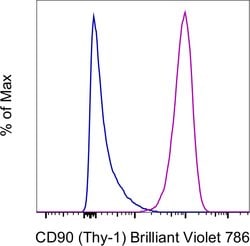Learn More
CD90 (Thy-1) Monoclonal Antibody (eBio5E10 (5E10)), Brilliant Violet™ 786, eBioscience™, Invitrogen™ 
Mouse Monoclonal Antibody
Supplier: Invitrogen 417090942
Description
The eBio5E10 mAb reacts with human CD90, also known as Thy-1 (thymus cell antigen-1). CD90 is a 25-35 kD receptor expressed on thymocytes, CD34+ prothymocytes, hematopoietic stem cells, neurons, a small subset of human fetal liver cells, cord blood cells, and bone marrow cells. CD90 is expressed on a subset of immature, CD34+ cells and a distinct subset of mature CD34- cells that are CD3+CD4+. The CD90+CD34+ population is enriched for cells capable of long-term culture. CD90 is involved in regulation of adhesion and signal transduction by T cells. Applications Tested: This eBio5E10 (5E10) antibody has been pre-diluted and tested by flow cytometric analysis of HEL cells. This may be used at 5uL (0.125ug) per test BV 786 is a tandem dye that emits at 786nm and is intended for use on cytometers equipped with a violet (405nm) laser. Please make sure that your instrument is capable of detecting this fluorochrome. When using two or more Super Bright, BV, BUV, or other polymer dye-conjugated antibodies in a staining panel, it is recommended to use Super Bright Complete Staining Buffer (SB-4401-42) or Brilliant Stain Buffer (00-4409-75) to minimize any non-specific polymer interactions. Light sensitivity: This tandem dye is sensitive to photo-induced oxidation. Excitation: 407nm; Emission: 786nm; Laser: Violet Laser. BV is a trademark or registered trademark of Becton, Dickinson and Company or its affiliates, and is used under license. Powered by Sirigen.
CD90 (Thy 1) antigen is a GPI linked glycoprotein member of the Immunoglobulin super family. CD90 is expressed in murine T cells, thymocytes, neural cells, Kupffer's cells and fibroblasts. CD90 may play a role in cell-cell or cell-ligand interactions during synaptogenesis and other events in the brain. CD90 can be used as a marker for a variety of stem cells and for the axonal processes of mature neurons. Structural study of CD90 led to the foundation of the Immunoglobulin superfamily, of which it is the smallest member, and led to the first biochemical description and characterization of a vertebrate GPI anchor. Diseases associated with CD90 dysfunction include nasopharyngeal carcinoma and thymoma.Spécifications
| CD90 (Thy-1) | |
| Monoclonal | |
| 5 μL/Test | |
| PBS with BSA and 0.09% sodium azide; pH 7.2 | |
| P04216 | |
| Thy1 | |
| Affinity chromatography | |
| RUO | |
| 7070 | |
| 4° C, store in dark, DO NOT FREEZE! | |
| Liquid |
| Flow Cytometry | |
| eBio5E10 (5E10) | |
| Brilliant Violet 786 | |
| Thy1 | |
| CD7; CD90; CDw90; FLJ33325; membrane glycoprotein; T25; Thy 1.2; THY1; Thy-1; Thy-1 antigen; Thy-1 cell surface antigen; thy-1 glycoprotein; thy-1 membrane glycoprotein; Thy-1 protein; Thy-1 T-cell antigen; Thy1.1; Thy1.2; Thy-1.2; thymus cell antigen 1, theta; Thymus cell surface antigen | |
| Mouse | |
| 100 Tests | |
| Primary | |
| Human | |
| Antibody | |
| IgG1 κ |



